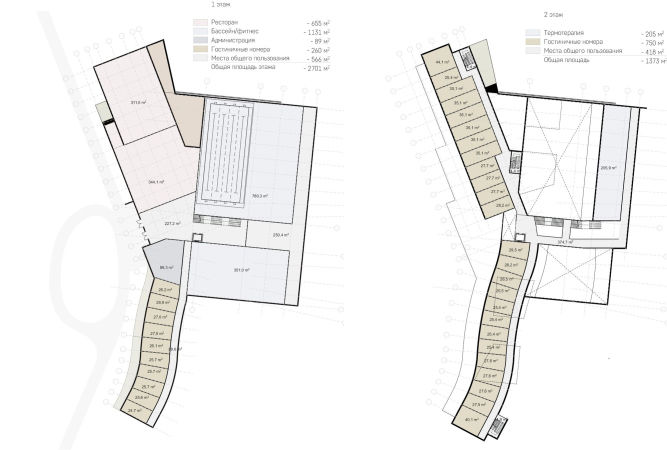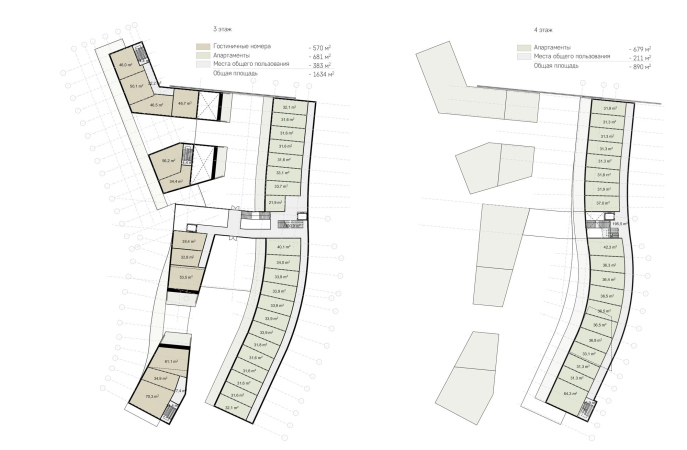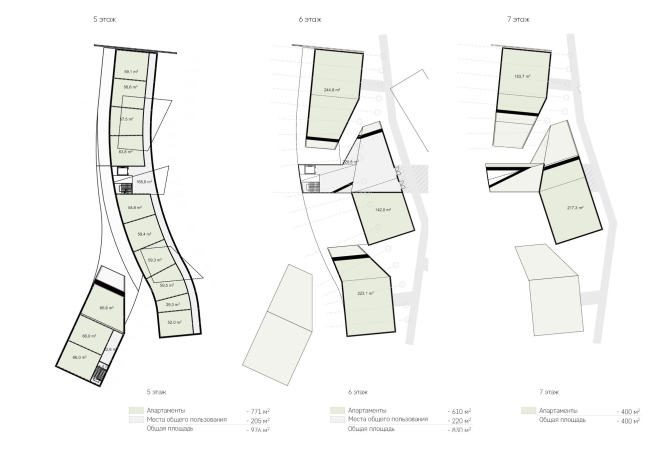This is not the first time that the ASADOV team works in Kaliningrad Oblast. In 2018, it was a housing project named “Russian Europe”. Still earlier, a competition project for the Kaliningrad Music Theater. And here is a new project – the picturesque Baltic shore, marked by the world-renowned eco-label, UNESCO blue flag, a long wooden promenade running along the sea shore, and the Sinyavinskoe Lake behind it – a haunt of the local divers. This beautiful scenery will surround the hotel complex with green terraces, a swimming pool, and a park ensemble.
The request of developing the concept of a hotel complex was forwarded to ASADOV Bureau by the communication agency ARS MEDIA GROUP (A.M.G.), who at that moment was already working with the client on that project. The architects were given an ambitious task of not just designing a seaside hotel but coming up with a new format of a recreational complex, considering the complex historical background and natural surroundings.
Amber Residence hotel complex in Yantarny
Copyright: © ASADOV architects
The settlement of Yantarny is quite small; it stretches along the sea shore. The place is known for the cleanest and widest beaches in the region, and, of course, its amber mines. Amber has been mined here since the XVII century, when the settlement was called Palmnicken, and the amber mining is still going on.
The hotel was to be built on a 1.3-hectare land site. It occupies the entire slope from the derelict amber mine Anna down to the active “Galera” restaurant built as a wooden ship with a large parking lot and a wide strip of sand next to it.
Amber Residence hotel complex. Master plan
Copyright: © ASADOV architects
The mine Anna borders the land site from the north. In January 2011, they installed a memorial on the territory of the former mine in memory of Palmnicken massacre when thousands of prisoners of concentration camps were shot here in the winter of 1945. Designed by the Israel sculptor Frank Meisler, the monument – composed of hands reaching up in the air and holding numbers, which the prisoners were assigned instead of their names – was created on the funds sponsored by the local Jewish community. Today, each year, Yantarny witnesses a mourning march commemorating those tragic events.
When the project was considered by the regional town planning council, one of the main questions that arose was about incompatibility of the entertainment function and the tragic historical background. However, come to think of it, currently the territory around the monument is a haunt of the local residents and tourists – a beach, a promenade, a restaurant, and a scatter of summer cafes. The new complex, as the designers hope, will enhance the cultural significance of this place. Andrey Asadov shares that together with the Jewish community they are discussing the idea of creating a Jewish center of culture and tolerance that will present not only the history of this nation but also the pictures by the modern painters from all over the world. Next to the memorial, there will appear an amphitheater. And the seaside zone with its sand dunes will get an art park in the stead of the former parking lot for staging regular shows and festivals. The task of organizing such activities will be readily tackled by A.M.G, the curator of such events as “Circle of Light” and “Perm, the Cultural Capital”.
Amber Residence hotel complex in Yantarny
Copyright: © ASADOV architects
At the current design stage, ASADOV Bureau, in collaboration with A.M.G, is searching for the optimum format. So far, all parties are leaning toward the idea of a back office, the venue for visiting working sessions and conferences. It must be said that both location and transport accessibility (about a 50-minutes’ drive from Kaliningrad) are quite conducive to that idea.
The search for the solution of developing the Yantarny territory even brought about the launch of a new research project Development 2.0. According to Andrey Asadov, the project already conducted a series of Instagram live streams, devoted to “development and architecture of tomorrow”. Mind, all of these things sprang from this single project of a local scale.
Amber Residence hotel complex in Yantarny
Copyright: © ASADOV architects
The history of the place defined the functional content of the building. The natural surroundings made the basis for the historical solution. As a rule, a hotel claims the role of a centerpiece – in the city, oftentimes, these are multistory, high-profile buildings. In the case of the Yantarny hotel complex, it is exactly the other way around. The land site occupies a steep slope with a relief drop of about 20 meters. And the entire seven-story complex hides in this slope, masked by green roofs, and becoming a part of nature itself.
The building has sophisticated geometry that almost exactly follows the natural topography. The stories follow horizontals of the terrain, ascending the slope in broad ledges. The flat operated roof of each lower tier becomes the terrace for the ensuing upper floor, striving to recreate the character of a sea cliff, green and hilly.
Amber Residence hotel complex in Yantarny
Copyright: © ASADOV architects
Generally speaking, terraced buildings are one of the oldest types of construction. Since the days of the Ancient Rome, humanity has not yet invented a technique as efficient that would make it possible to make the most out of complex terrain without having to make significant changes to it.
The whole complex consists of six single and double-story lines of construction and seven floors, counting which could be quite tricky – because they are arranged on the slope in such a sophisticated way. The widest line – situated above the third floor – conditionally divides the zones of the hotel and the apartments: 47 hotel rooms are situated on the first three floors, and 50 long-stay apartments occupy the remaining part of the building up the hill.
Amber Residence hotel complex. Section view
Copyright: © ASADOV architects
The broad terrace between the third and fourth floors has a real park on it with full-size trees and shrubs. There is a whole system of lawns, courtyards, walking trails, boardwalks, flowerbeds, and hotel rooms, packed into several separate volumes underneath sloping green roofs that serve as the continuation of the park space. One can ascend them like a hill, sit on a lawn in solitude, and admire the sea panorama from this height.
Amidst the lush vegetation, one will have a hard time spotting the stained glass windows of the facades, playing with reflections of sunlight – all of the hotel rooms and apartments are turned to the water with their panoramic windows. From the side of the sea, and when viewed from above, the complex looks more like a terraced garden in the spirit of park ensembles of Italian Renaissance than like a seven-story building with a total area of 13700 square meters.
Amber Residence hotel complex
Copyright: © ASADOV architects
Amber Residence hotel complex
Copyright: © ASADOV architects
Approximately in the middle of the building, an elongated glass atrium descends down to the sea, looking from a distance like a waterfall, with a grand staircase that connects all the tiers of the complex.
Amber Residence hotel complex. The functional arrangement
Copyright: © ASADOV architects
The first floor of the complex will include a restaurant opened not only for the guests at the hotel but also to everybody, a swimming pool, a fitness area, a conference hall, and a culture center. The latter will have an individual entrance from the side of the memorial. In front of the entrance, there will be an open air amphitheater for 200 people.
Amber Residence hotel complex. The townhouses
Copyright: © ASADOV architects
In addition to the main volume of the building, along the shore line, and close to one of the creeks that dissect the sand surface of the beach, there will appear nine three-story townhouses. Each of them will contain six individual apartments. The townhouses are turned to the sea with their laconic reserved facades and large stained glass windows under gable roofs. In front of them, there are also small green terraces. The proximity to the water, the transparency of architecture, and the scale of construction make one instantly think that they are at some Mediterranean seaside resort. However, let’s get back to the reality: the Baltic Sea can be tough even in summer. Hence the easily readable Scandinavian features of a warm and reliable dwelling.
Amber Residence hotel complex. The townhouses
Copyright: © ASADOV architects
Amber Residence hotel complex. The townhouses
Copyright: © ASADOV architects
Amber Residence hotel complex. The townhouses
Copyright: © ASADOV architects
We must note that so far the functional program of the complex has not yet received its final approval, and will probably be subject to change in the course of further development. We can only be sure about the architectural part – a peculiar manifesto of eco-architecture, supported by the professional community of the region and general public as well. The authors of the project hope that the complex will not become a thing in itself, but, thanks to the input from the Jewish Center and the art park will give a momentum to the cultural develop of this place, becoming a new center of attraction in the Kaliningrad Oblast.



















































